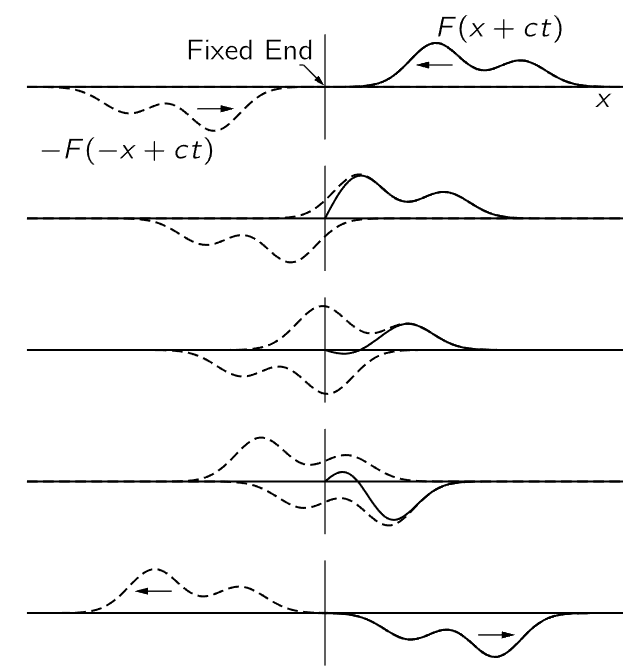
The reflection of waves
 المؤلف:
Richard Feynman, Robert Leighton and Matthew Sands
المؤلف:
Richard Feynman, Robert Leighton and Matthew Sands
 المصدر:
The Feynman Lectures on Physics
المصدر:
The Feynman Lectures on Physics
 الجزء والصفحة:
Volume I, Chapter 49
الجزء والصفحة:
Volume I, Chapter 49
 2024-06-18
2024-06-18
 1741
1741
Our first example of confining waves will be to confine a wave at one boundary. Let us take the simple example of a one-dimensional wave on a string. One could equally well consider sound in one dimension against a wall, or other situations of a similar nature, but the example of a string will be sufficient for our present purposes. Suppose that the string is held at one end, for example by fastening it to an “infinitely solid” wall. This can be expressed mathematically by saying that the displacement y of the string at the position x=0 must be zero, because the end does not move. Now if it were not for the wall, we know that the general solution for the motion is the sum of two functions, F(x−ct) and G(x+ct), the first representing a wave travelling one way in the string, and the second a wave travelling the other way in the string:

is the general solution for any string. But we have next to satisfy the condition that the string does not move at one end. If we put x=0 in Eq. (49.1) and examine y for any value of t, we get y=F(−ct)+G(+ct). Now if this is to be zero for all times, it means that the function G(ct) must be −F(−ct). In other words, G of anything must be −F of minus that same thing. If this result is put back into Eq. (49.1), we find that the solution for the problem is

It is easy to check that we will get y=0 if we set x=0.

Fig. 49–1. Reflection of a wave as a superposition of two travelling waves.
Figure 49–1 shows a wave travelling in the negative x-direction near x=0, and a hypothetical wave travelling in the other direction reversed in sign and on the other side of the origin. We say hypothetical because, of course, there is no string to vibrate on that side of the origin. The total motion of the string is to be regarded as the sum of these two waves in the region of positive x. As they reach the origin, they will always cancel at x=0, and finally the second (reflected) wave will be the only one to exist for positive x and it will, of course, be travelling in the opposite direction. These results are equivalent to the following statement: if a wave reaches the clamped end of a string, it will be reflected with a change in sign. Such a reflection can always be understood by imagining that what is coming to the end of the string comes out upside down from behind the wall. In short, if we assume that the string is infinite and that whenever we have a wave going one way we have another one going the other way with the stated symmetry, the displacement at x=0 will always be zero and it would make no difference if we clamped the string there.
The next point to be discussed is the reflection of a periodic wave. Suppose that the wave represented by F(x−ct) is a sine wave and has been reflected; then the reflected wave −F(−x−ct) is also a sine wave of the same frequency, but travelling in the opposite direction. This situation can be most simply described by using the complex function notation: F(x−ct)=eiω(t−x/c) and F(−x−ct)=eiω(t+x/c). It can be seen that if these are substituted in (49.2) and if x is set equal to 0, then y=0 for all values of t, so it satisfies the necessary condition. Because of the properties of exponentials, this can be written in a simpler form:

There is something interesting and new here, in that this solution tells us that if we look at any fixed x, the string oscillates at frequency ω. No matter where this point is, the frequency is the same! But there are some places, in particular wherever sin(ωx/c)=0, where there is no displacement at all. Furthermore, if at any time t we take a snapshot of the vibrating string, the picture will be a sine wave. However, the displacement of this sine wave will depend upon the time t. From inspection of Eq. (49.3) we can see that the length of one cycle of the sine wave is equal to the wavelength of either of the superimposed waves:

The points where there is no motion satisfy the condition sin(ωx/c)=0, which means that (ωx/c)=0, π, 2π, …, nπ, … These points are called nodes. Between any two successive nodes, every point moves up and down sinusoidally, but the pattern of motion stays fixed in space. This is the fundamental characteristic of what we call a mode. If one can find a pattern of motion which has the property that at any point the object moves perfectly sinusoidally, and that all points move at the same frequency (though some will move more than others), then we have what is called a mode.
 الاكثر قراءة في الفيزياء الذرية
الاكثر قراءة في الفيزياء الذرية
 اخر الاخبار
اخر الاخبار
اخبار العتبة العباسية المقدسة


